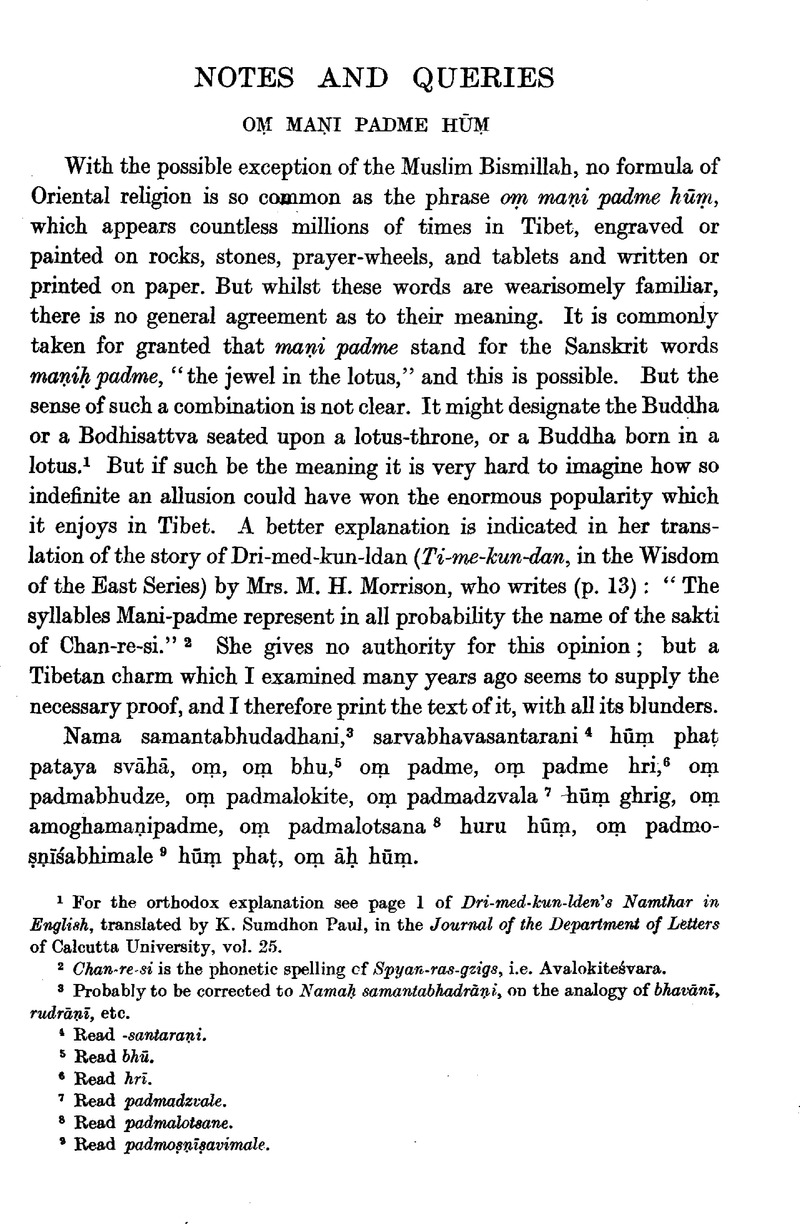No CrossRef data available.
Article contents
Abstract

- Type
- Other
- Information
- Bulletin of the School of Oriental and African Studies , Volume 8 , Issue 4 , February 1937 , pp. 1195 - 1198
- Copyright
- Copyright © School of Oriental and African Studies 1937
References
page 1195 note 1 For the orthodox explanation see page 1 of Dri-med-kun-lden's Namthar in English, translated by Paul, K. Sumdhon, in the Journal of the Department of Letters of Calcutta University, vol. 25.Google Scholar
page 1195 note 2 Chan-re-si is the phonetic spelling of Spyan-ras-gzigs, i.e. AvalokiteśVara.
page 1195 note 3 Probably to be corrected to Namaḥ samantabhadrāṇi, on the analogy of bhāvānī, rudrāṇī, etc.
page 1195 note 4 Read -santarani.
page 1195 note 5 Read bhū.
page 1195 note 6 Read hrī.
page 1195 note 7 Read padmadzvale.
page 1195 note 8 Read padmalotsane.
page 1195 note 9 Read padmoṣṇīṣavimale.
page 1196 note 1 On Lokeśvara, Samantabhadra see Sādhanamālā, ed. Bhattacharyya, B., p. 183.Google Scholar
page 1196 note 2 Sādhanamālā, p. 180.Google Scholar
page 1196 note 3 Sādhanamālā, p. 33.Google Scholar
page 1196 note 4 Sādhanamālā, p 35.Google Scholar
page 1196 note 5 I have to thank Mr. G. R. Driver (Oxford) for advice on various points of Babylonian philology.
page 1196 note 6 See a recent discussion of Kassite by Mironov, N. D., Ada Orientcdia, xi, 142 ff., where references to further literature will be found.Google Scholar
page 1197 note 1 Scheftelowitz, J., Zeitschrift filr vergleichende Sprachforschung, xxxviii, 261, suggests that the u is due to the influence of the preceding labial, but this view has not found general acceptance.Google Scholar
page 1197 note 2 The Kassite material is presented in a convenient form by Pinches, T. G., Journal of the Royal Asiatic Society, 1917,101–114 Google Scholar (cf. particularly the “ King-List ”, pp. 106–7, and the “ Vocabulary ”, pp. 102–5); see also Delitzsch, F., Die Sprache der Kossāer.Google Scholar
page 1197 note 3 Walde, A. and Pokorny, J., Vergleichendes Wörterbuch der indogermanischen Sprachen, ii, 155 ff.Google Scholar
page 1197 note 4 Bezold, C., Proceedings of the Society of Biblical Archæology, ix, 377.Google Scholar
page 1197 note 5 The form ubryaš, which is apparently equivalent to buryaš (cf. Vocabulary 6 ub-ri-ia-aš ‗ ilu Addu, Rammānu “ Hadad, Rimmon ”), is obscure. For such a“ metathesis ”—whatever its explanation—we may perhaps compare Ug-ba-ru(? ‗ normal Gu-ba-ru); see Smith, S., Babylonian historical texts relating to the capture and downfall of Babylon, pp. 121–2.Google Scholar
page 1197 note 5 See Charpentier, J., Indogermanische Forschungen, xxix, 378–9. The exact relation of the Kassite and Greek suffixes is not clear.Google Scholar
page 1197 note 7 Walde-Pokorny, , op. cit., ii, 128.Google Scholar
page 1198 note 1 On b or bh see Charpentier, loc. cit.
page 1198 note 2 We have no evidence to determine the date at which this Ind.-Ir. change took place. The parallel change of IndE. ě, ē > Ind.-Ir. ă, ā certainly took place after the Ind.-Ir. palatalization of the gutturals before front vowels (J. Wackernagel, Altindische Grammatik, § 119 ff.), but, even if we assume that this latter change was contemporary with the change under discussion, this can afford us no more than a relative date. It should also be note d here that, despite the position maintained by H. Jacobsohn (who follows Andreas) in his Arier und Ugrofinnen, the lexicographical correspondences between Primitive Finno-Ugrian and Indo-European, often regarded as due to “ Pre-Aryan” loans in Primitive Finno-Ugrian cannot afford us any assistance indetermining the date of the change of IndE. ŏ to Ind.-Ir. ă. See B., Collinder, Indouralisches Sprachgut Google Scholar and Ross, A. S. C., BSOS., viii, 1, pp. 227–234, 1935.Google Scholar


